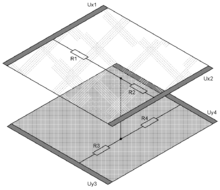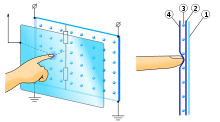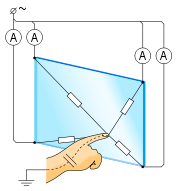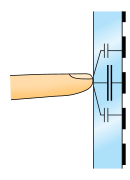Operating principals and technologies of sensory equipment
|
Table of Contents
Operating principles of touch screens
Resistive touch screens - Four wire screen - Five wire screen Matrix touch screens - Construction and operation principle - Features Capacitive touch screens - Construction and operation principle Projective-capacitive touch screens - Construction and operation principle - Features Touch screens on surface acoustic waves - Construction and operation principle - Features Infra-red touch screens - Features Optical touch screens - Features Strain Gauge touch screens Induction touch screens Summary table |
Operating principles of touch-screens
There are many different types of touch screens that work on different physical principles.
Resistive touch-screens
Four wire screen
A resistive touch screen is composed of glass panels and a flexible plastic membrane. The panel and membrane are coated with a resistive material. The space between the glass and the membrane is filled with mikroinsulators which are evenly distributed on the active area of the screen and reliably insolate the conductive surface. When the screen is touched the membrane and panel make contact and controllers using an analog-to-digital converter register a change of resistance and convert it into touch coordinates (X and Y). In general terms the algorithm for reading is as follows:
1. The upper electrode voltage is 5V and the lower is grounded. Left and right are shorted and the voltage on them is checked. This voltage corresponds to the Y-coordinate of the screen.
2. The left and right electrodes are 5V and the "Earth" from top and bottom is the X-coordinate.
There are also eight wire touch screens. They improve tracking accuracy but do not improve reliability.
Five wire screen
The five wire screen is more reliable due to the fact that the resistive coating on the membrane is replaced by a conductive coating (5-wire screen keeps running even with a slotted membrane). The rear glass has a resistive coating with an electrode in each corner.
Initially all four electrodes are grounded and the membrane is "pulled" by a resistor to + 5V. The voltage level on the membrane is continuously monitored by an analog to digital converter. When nothing touches a touch screen the voltage is 5V.
As soon as the screen is clicked the microprocessor detects membrane voltage changes and starts to calculate touch coordinates as follows:
1. Two right electrodes have 5V, left are grounded. Voltage on the screen corresponds to X- coordinate.
2. Y-coordinate is read connecting both upper electrodes to +5V and both lower to "Earth".
Matrix touch screens
Design and operating principle
The design basically corresponds to resistance, but simplified to the utmost. The glass is coated with horizontal conductors while a membrane is coated with vertical conductors.
When touching the screen the conductors make contact. The controller determines which conductors become locked and passes appropriate coordinates to the microprocessor.
Features
Very low accuracy. The interface elements are specially placed according to the cells of the matrix screen. The only advantage is simplicity and cheapness. Usually matrix screens are presented by lines (similar to a matrix of buttons); this allows for tuning multi-touch. Gradually these are replaced by resistive screens.
Capacitive touch screens
Design and operating principle
Capacitive (surface capacitive) screens use the fact that the material conducts high capacity AC current. A capacitive touch screen is a glass panel covered with a transparent resistive material (typically an alloy of indium oxide and tin oxide). Electrodes which are placed on the corners of the screen send a small AC current on the conductive layer (same for all corners). When you tap the screen with your finger or other conductive object there is a current leakage. The nearer the finger is to the electrode the less resistance of the screen and thus the current is stronger. The current in all four corners is recorded by sensors and transmitted to the controller which calculates the coordinates of the touch point.
In earlier models of capacitive screens a DC current was used. This simplifies the design but with poor contact with the user causing Earth leads to fail.
Capacitive touch screens are reliable, with a span of about 200 million clicks (about 6,5 years of tapping with an interval of one second); they do not release the fluid and can perfectly tolerate non-conducting pollution. Transparency is at the level of 90%. However, the conductive coating is still vulnerable. Therefore capacitive screens are widely used in slot-machines installed in a secure room. They do not respond to a hand in a glove.
Projective-capacitive touch screens
Construction and operation principle
On the inner side of the screen is a grid of electrodes. Electrode within a body forms a capacitor; electronics measure capacity of this condenser (takes a pulse of the current and measures the voltage).
Features
Transparency of such screens is up to 90%, temperature range is extremely broad; very durable (narrow place - sophisticated electronics, manufacturing pressed). PEE can be applied to the glass with a thickness of up to 18 mm, making them extremely vandal proof. They do not react to non-conducting pollution; conduction is easily suppressed programmatically. Therefore projective-capacitive touch screens are used in slot-machines installed in the street. Many models react to hands in a glove. Modern models have very high accuracy, however the vandal proof implementation makes them less precise.
PEE reacts even to an approaching touch — the threshold is set programmatically. Pressing by hand is distinguished from pressing with a conducting pen. Some models support multitouch. Therefore this technology is used in touch-pads and multitouch screens.
It's worth noting that due to differences in terminology surface and projective capacitive screens are often confused.
Touch screens on surface acoustic waves
Construction and operation principle
The screen is a glass panel with a piezoelectric converter (PEC) located on the corners. On the edges of the panels there are reflecting and receiving sensors. The principle of such a screen is as follows:
A special controller generates a high-frequency electrical signal and sends it to the PEC. The PEC converts this signal to PAV and reflecting converters reflect it accordingly. These reflected waves are received by corresponding sensors and sent to the PEC. The PEC in turn takes the reflected waves and converts them into an electrical signal which is then analyzed using a controller. When you tap the screen with your finger some of the energy of acoustic waves is absorbed. Receivers record the change and a microcontroller calculates the position of the touch point. It reacts to touch with an object able to absorb the wave (finger, hand in glove, cellular rubber).
Features
The main advantage of the screen based on surface acoustic waves (SAW) is the ability to track not only the coordinates of points but the pressure (or rather the ability to accurately determine the radius or pressing area) due to the fact that the degree of absorption of acoustic waves depends on the pressure at the point of touch (note that the screen doesn’t sag under the finger and does not deform so pressing strength does not cause qualitative changes in the processing of the data of exposure coordinates by the controller which fixes only on the area blocking the path of acoustic pulses). This device has a very high transparency as light from the displaying device passes through glass not containing resistive or conductive coatings. In some cases to counter the glare, glass is not used. Instead, emitters, receivers and reflectors are attached directly to the screen of the showing device. Despite the complexity of the design these screens are quite durable. For example, according to a statement by the American company Tyco Electronics and the Taiwanese firm General Touch these screens can withstand up to 50 million touches in one point. That exceeds the capacity of 5-wire resistive screens. Screens based on SAW are applied basically at slot machines, in protected information systems and educational institutions. Generally SAW screens are available in the usual - 3 mm thick and vandal-resistant-6 mm variants. The latter can withstand a man’s blow or a falling metal ball weighing 0.5 kg from a hight of 1.3 meters (according to Elo Touch Systems information). Those on the market offer options for connecting to your computer via RS232 interface or via USB interface. Today touch screen controllers with SAW that support both types of connections are increasingly popular (Elo Touch Systems information).
The main disadvantage of the screen based on SAW is its susceptibility to vibration or the impact of acoustic noise and when the screen becomes dirty. Any foreign object placed on the screen (such as chewing gum) completely blocks its functionality. In addition this technology requires you to touch with an object which must absorb acoustic waves, for example a plastic bank card will not work.
The accuracy of these screens is higher than that of matrix but lower than traditional capacitive. They are generally not used to draw or enter the text.
Infrared touch screens
Operation principle of an infrared touch panel is simple: a grid formed by horizontal and vertical infrared beams is interrupted when the monitor is touched with any object. The controller determines the location at which the beam was interrupted.
Features
Infrared touch screens are susceptible to contamination and are therefore used for applications where image quality is important. Because of their simplicity and maintainability the design is popular with the military. This type of screen is used in mobile phones by Neonode company.
Optical touch screens
A glass panel equipped with IR lighting. On the edge of “glass-air” there is a full internal reflection, on the edge of a “glass-foreign object" light is scattered. We need only to film the picture to detect scattering. For this purpose there are two technologies:
- In the projection screen a camera is installed near the projector. For example, MicrosoftSurface works this way.
- Or, in light-sensitive screens an additional fourth sub pixel is added on an LCD screen.
Features
Able to distinguish clicks by hand or with an object, there is also multitouch. Possible to have large sensor surfaces up to the size of a blackboard.
Strain Gauge touch screens
These react to the deformation of the screen. Precision of strain gauge screens is small but they are vandal proof. Usage is similar to that of projective-capacitive touch screens: ATMs, ticket machines, and other devices located on the street.
Induction touch screens
The induction touch screen is a graphics tablet with a built-in screen. Such screens respond only to a special pen.
Used when you need to respond to the click of a pen (rather than by hand): art tablets of high-end class, some models of tablet PCs.
Summary table
|
Matrix |
4-wire |
5-wire |
Cap. |
Proj. Cap. |
SAW |
Infrared Grid |
Opt. |
Strain Gauge |
Induction | |
|
Functionality | ||||||||||
|
Hand in glove |
yes |
yes |
|
yes |
yes |
yes |
yes |
yes |
| |
|
yes |
yes |
yes |
yes |
|
yes |
yes |
yes |
| ||
|
Solid non-conductive object |
yes |
yes |
|
|
|
yes |
yes |
yes |
| |
|
Multitouch |
yes 1 |
|
|
|
yes |
|
yes 1 |
yes |
|
|
|
Measuring of click strength |
|
|
|
|
yes |
yes |
|
yes |
yes |
yes |
|
Limit transparency %2 |
85 |
75 |
85 |
90 |
90 |
95 |
100 |
100 |
95 |
90 |
|
Accuracy 3 |
low |
high |
high |
high |
average |
average |
average |
low |
high | |
|
reliability | ||||||||||
|
Lifetime, mil clicks |
35 |
10 |
35 |
200 |
∞4 |
50 |
∞5 |
∞4 |
??? |
∞4 |
|
Protection From mud and liquid |
yes |
yes |
yes |
yes |
yes |
|
|
yes |
yes |
yes |
|
Vandal proof |
|
|
|
|
yes |
|
|
yes |
yes |
|
|
Usage6 |
limited |
limited |
room |
street |
room |
room |
room |
street |
limited | |
1. Supported with limitations.
2. If you need only glass panel without any transparent conductive films – roughly 95%. If you don't need even that (you can apply regular coating on the screen) – roughly 100%.
3. High – up to 1 pixel (accurately tracks a sharp pen). The average is up to a few pixels (sufficient for clicks with finger). Low - large blocks of the screen (you cannot draw; you need very large interface elements).
4. Limited by reliability of electronics
5. Limited by pollution of sensor
6. Limited by equipment of limited access (personal electronics, industrial equipment). Room – sharing in a secure room. Street — sharing in the street






